A customer journey differs from a customer journey funnel in that a marketing funnel converts visitors into leads, and leads into customers, whereas a customer journey represents all the steps a person takes from awareness to consideration to conversion.
Conversion rate optimization experts rely on marketing funnels to analyze the entire buyer journey. Looking at each step in the journey, a business can see where the user gets hooked (i.e. commits to buying) or gets lost. That helps tighten the funnel to assure that you have your potential buyer’s awareness and, more importantly, his interest, every step through the process.
It isn’t until the very last stage (if your product is still under consideration) that a potential buyer becomes a customer.
The goal is not only to get customers to buy your products and services again. Business success depends on returning customers. Establishing customer loyalty and increasing trust in your brand will result in better customer retention.

Leading a customer down the path to sales success
Through regular engagement with your customers, you can further develop customer relationships. Your relationship with your customers doesn’t end once they’ve made a purchase.
The customer journey can be very simple or very complex, depending on your marketing strategy. By mapping your customer’s journey, you can better understand how your target market learns about your business, what catches their attention, when and why they make a purchase, and ultimately how to guide them more effectively and efficiently from beginning to end.
A customer journey can be thought of as a more detailed description of your marketing funnel – how you move people from awareness to conversion.
What Is the Sales Funnel Customer Journey?
To put it simply, a sales funnel is a series of pages designed to entice visitors to take a specific action. It might be opting into your email list, downloading a free resource, or purchasing something.
Depending on the model, a marketing funnel has several steps. Prospects become more committed to their purchase goals as they progress through the funnel. Each stage of the marketing funnel is guided by this model, regardless of whether the business is online or conventional.
Different marketing funnels are used for different goals, depending on what you want to accomplish. In the end, marketing funnels encourage your target market to take small, vital actions that drive revenue growth for your company.
Marketing Funnels inherited from the AIDA model typically consist of four stages:
Awareness – Consumers gain knowledge of categories, products, or brands (usually through advertising)
Interest – consumers learn about brand benefits and how the brand fits with their lifestyle
Decision – Consumers develop a positive attitude toward the brand
Action – The consumer makes a purchase decision, shops around, engages in trials, or completes a purchase
It is based on the assumption that consumers will move through experience-specific stages (AIDA) during their decision-making process.

The customer journey starts with quality SEO
Customer Journey Maps
A Customer Journey Map refers to the entire lifecycle of a customer, from the time he or she becomes aware of a specific need to the time he or she becomes habitual with your product or service.
Customer journey maps (CJMs) may also focus exclusively on certain interactions or stages of your brand’s relationship with a customer (complaints, renewals, online purchases).
CJM allows us to understand what customers go through and improve their experience, ensuring consistency and seamless service across all channels and touchpoints. Listening to your customers and learning how they feel about the steps through the journey is the most effective way to improve.
Customer Journey Mapping visualizes the end-to-end customer experience in a compact way. Businesses are empowered to make value-driven decisions based on a customer experience model when they better understand their customer’s behaviors, thoughts, and feelings.
At every step of the customer journey, SEO plays a role. “SEO is really the beginning of the funnel process,” explains Brad Weber, Founder and CEO of Avita Group, a California digital marketing agency specializing in Search Engine Optimization. “Taking a link from a Google search result is the first introduction a user has to your product or service. From there, it’s up to the website’s experience when a user decides to buy or bail.”
Best practices for customer journey mapping:
- Rather than focusing on your company, consider the category
Companies working on customer journey maps should understand that CJM begins before there s an actual relationship.
There has been a focus on the point at which money changes hands, or on brand awareness. Although those moments are significant, they are hardly the beginning of the journey, and you will miss most of it if you start there.
The journey should begin as soon as a prospective customer becomes aware of the category. Your company provides a solution to their unsolved problem — or, more importantly, they become aware that there is a solution, and that you are a provider of it. The discussion of their sources of information is the beginning of the map.
- Remember to conquer as well as divide
Sometimes dividing is necessary for economic or political reasons. It can take many months for a large corporation to complete a full-blown customer journey – especially if it involves a half-dozen unique roles. Perhaps splitting budgets over years or rallying the team around a big change and a big win can be helpful as a starting point.
Don’t lose sight of the bigger picture because it’s easy to stay narrowly focused. Do your research on a part of the customer journey map, but don’t forget to look at the whole journey.
After mapping the customer’s experience, you’ll have a much broader understanding of the emotions, thoughts, encounters, and decisions that brought them to the point of a problem.
- Consider the pain points and gaps of real customers
You’re going to miss at least two-thirds of the picture if you don’t talk to any customers. When we assume that what matters inside the building matters to customers, it is dangerous.
When real customers recount their experiences, you need to know where their pain is, where their confusion is, and where your company is falling short. Achieving that will always lead to useful, actionable results.
It’s also important to protect your online reputation on social platforms which we wrote about previously.
The marketing funnel represents the strategic framework that businesses use to guide potential customers through distinct stages of the buying process, from initial awareness of a problem or need, through consideration of various solutions, and finally to the decision to purchase.
This funnel-shaped model acknowledges that not everyone who becomes aware of your brand will ultimately become a customer, with prospects naturally dropping off at each stage as they qualify themselves in or out.
The customer journey, meanwhile, is the actual experience and path that individual customers take as they interact with your brand across multiple touchpoints and channels.
The marketing funnel directly shapes this journey by determining what content, messaging, and offers customers encounter at each stage. For example, awareness-stage funnel tactics like blog posts and social media content become the customer’s first touchpoints, while decision-stage tactics like free trials or consultations become the final experiences before purchase.
When aligned properly, the marketing funnel creates a seamless customer journey that feels natural and helpful rather than pushy, meeting prospects with the right information at precisely the moment they need it.
Creating a Marketing Funnel
Awareness
- Consumer research and marketing campaigns
- Advertisements, trade shows, blogs, webinars, direct mail, viral campaigns, social media, search media mentions, and more
Using SEO to Build Awareness
SEO strategies for building awareness target low-intent keywords from users who may not even realize they are interested in buying anything.
Essentially, you are building a collection of high-ranking content relevant to the topical interests of your target audience. This content could reference your product/service in some way or subtly promote the need for something like them, but it’s generally a good idea to refrain from sales talk.
Here’s where we recommend getting listed in free online directories that will boost your business.
Ideally, your brand name and content should be discovered by relevant audiences. This is what makes professional search engine marketing agencies like Avita Digital a smart solution to ensure you are properly using SEO to build awareness for your company or brand.
Interest
- Introduction to positioning and engagement
- Newsletters, emails, classes, and targeted content
Consideration
- Specials and product information
- Free trials, case studies, automated email campaigns, and more
Intent
- Shopping carts and product demos
- The nurture stream is enhanced by sales
Evaluation
- Sales and marketing work together to convince customers that their product is the best
Purchase
- The sales transaction has been completed
Marketing Funnel best practices:
- Drive traffic effectively
You should concentrate your efforts on identifying the audience that is most likely to convert. Using lookalike audiences, segmenting your social media ads, and observing which users perform your desired actions are all ways to do this.
If some groups, in particular, are visiting your site but not converting, it might be best to remove them from your target group or modify your ads to suit their needs.
- Provide a seamless communication experience across all devices
Your website, landing pages, and emails must be mobile-friendly. When any of those assets aren’t working on mobile devices, ask yourself whether you still want to target mobile users.
Check whether mobile users are converting, and if not, decide whether you want to target them. This is such an important aspect of your digital marketing strategy and to your marketing funnel working the best it can for your business.
- Choose the right lead magnet for your business.
Maybe a checklist will win out over an ebook? Instead of a one-on-one consultation, why not send an email swipe file? Make sure to evaluate each lead magnet, but don’t focus solely on the money.
Often, what matters is how quickly your audience can benefit from the lead magnet and not how comprehensive it is. For example, think about that ebook you downloaded but never read because it was too long.
- Invest in nurturing your leads
Marketing funnels are all about targeting customers with relevant content at the right time. Be careful not to ask for a commitment too soon. If someone has already arrived with the mindset of ‘I’m ready to buy,’ you hint at the address of the order form. Others need nurturing first.
- Establish the right objectives and metrics
As marketers, we often get this wrong. Our focus is on vanity metrics. Actionable metrics are what we’re looking for.
What is more important to you, how many people visited your page or how many of them converted? Would you like to know how many people opened your email or clicked through to your upsell offer?
Make sure that you are focusing on the right metrics – those you can influence and that will lead to business growth – after you have written down your objectives.
- Increase your conversion rate by experimenting
Despite knowing your target audience very well, chances are that you have more than one idea of how to best reach them. Instead of relying on your gut instinct, run A/B tests on your ideas. What can you test?
Don’t just change the color of your CTA buttons – these things might not have a significant impact on your conversion rates. A variety of copy, placement of your signup form, social proof, videos, and advice from five-star rated web conversion experts like Avita Group can help you increase conversion rates and grow your business.
Conclusion
In the business and marketing world, you likely hear a lot about marketing funnels and customer journey maps. Although these concepts are closely related, they are not equivalent.
A customer journey details the steps a lead takes to become a paying customer, whereas a marketing funnel describes how businesses market to leads at different stages of the buying cycle. Despite not being the same thing, your marketing funnel and your customer journey maps should tell the same story.
Use the data collected from your leads’ touchpoints to inform your marketing funnel. By combining these tools, you can create a smoother and more user-friendly path to purchase while targeting your marketing materials to the right leads.
FAQs
Q – What is the primary purpose of a marketing funnel, and how does it differ from a customer journey?
A – A marketing funnel primarily focuses on the steps a potential customer takes toward making a purchase, while a customer journey encompasses the entire experience a customer has with a brand, from awareness to post-purchase interactions.
Q – Are there distinct stages in a marketing funnel that align with specific phases in the customer journey?
A – Yes, the stages in a marketing funnel, such as awareness, consideration, and conversion, align with various phases of the customer journey, ensuring a seamless transition from initial awareness to the final purchase.
Q – Can a customer journey exist without a formal marketing funnel strategy in place?
A – Yes, a customer journey can exist independently of a marketing funnel. While a marketing funnel provides a structured approach, a customer journey considers a broader range of interactions, including pre-purchase research, customer support, and post-purchase experiences.
Q – How do customer touchpoints differ in a marketing funnel compared to the customer journey?
A – Customer touchpoints in a marketing funnel are often transaction-focused, whereas those in a customer journey encompass a wider array of interactions, including social media engagement, customer reviews, and post-purchase communication.
Q – In what ways does technology influence the evolution of marketing funnels and customer journeys?
A – Technology plays a significant role in shaping both marketing funnels and customer journeys, with innovations like AI, data analytics, and personalized marketing strategies enhancing the overall customer experience.
Q – How do businesses effectively integrate the concepts of marketing funnels and customer journeys into their overall marketing strategy?
A – Businesses can integrate these concepts by aligning marketing funnel stages with corresponding customer journey phases, ensuring a comprehensive approach that addresses both the sales process and the overall customer experience.
Q – Are there key metrics that businesses should track differently for marketing funnels versus customer journeys?
A – Yes, while conversion rates and lead generation are critical for marketing funnels, customer satisfaction, loyalty, and lifetime value become essential metrics when evaluating the success of the entire customer journey.
Q – Can a marketing funnel be considered a subset of the broader customer journey?
A – Yes, a marketing funnel can be viewed as a subset of the customer journey, focusing specifically on the stages leading to a transaction. The customer journey encompasses the entire relationship, including pre and post-purchase interactions.
Q – How does the level of personalization differ between marketing funnels and customer journeys?
A – Marketing funnels often involve targeted messaging to guide customers through predefined stages, whereas customer journeys emphasize personalized experiences at every touchpoint, considering individual preferences and behaviors.
Q – What role do customer behaviors and preferences play in shaping both marketing funnels and customer journeys?
A – Customer behaviors and preferences significantly influence the design of marketing funnels and customer journeys, with businesses adapting strategies to align with the evolving expectations and needs of their target audience.
ABOUT AVITA GROUP
Avita Group is one of the longest-tenured, five-star rated digital marketing agencies in California. Our clients often have had previous agency experiences and ultimately find a long-term home with Avita Group.
We offer fractional CMO services to boost your brand and your business specializing in organic Search Engine Optimization (SEO), Pay Per Click (PPC) campaign management and Online Reputation Management (ORM).
The Avita Group team boasts a collective experience of over 30 years in the industry led by Founder and CEO, Brad Weber, and has worked with a variety of multi-million dollar companies to help them improve their ROI, build better brand awareness, and mitigate negative online reviews.
Contact us for a free consultation to evaluate how we can transform and elevate your business.
